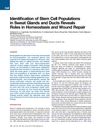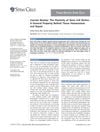Search
for
Did you mean Microenvironment?
Learn
5 / 6 resultslearn Thymosin Beta 4
learn sh-Polypeptide-7
learn Beta Polypeptide
learn Osteopontin
signaling protein that, when suppressed, may grow hair by reducing inflammation and stem cell loss
Research
5 / 1000+ resultsresearch Reprogramming of Three-Dimensional Microenvironments for In Vitro Hair Follicle Induction
Reprogramming 3D environments can create hair follicles in the lab.

research Biological and Mechanical Influence of Three-Dimensional Microenvironment Formed in Microwell on Multicellular Spheroids Composed of Heterogeneous Hair Follicle Stem Cells
3D microenvironments in microwells improve hair follicle stem cell behavior and hair regeneration.

research Identification of Stem Cell Populations in Sweat Glands and Ducts Reveals Roles in Homeostasis and Wound Repair
The study found that sweat glands contain different types of stem cells that help with healing and maintaining healthy skin.

research Concise Review: The Plasticity of Stem Cell Niches: A General Property Behind Tissue Homeostasis and Repair
Stem cell niches are adaptable and key for tissue maintenance and repair.

research Building and Maintaining the Skin
Three types of stem cells help maintain and repair skin, responding to health and environmental changes.
Community Join
5 / 11 resultscommunity Polydopamine Synergizes with Quercetin Nanosystem to Reshape the Perifollicular Microenvironment for Accelerating Hair Regrowth in Androgenetic Alopecia.
A quercetin-encapsulated and polydopamine-integrated nanosystem (PDA@QLipo) shows promise for treating androgenetic alopecia by reshaping the perifollicular microenvironment, outperforming minoxidil in hair regeneration. The nanosystem promotes cell proliferation, hair follicle renewal, and recovery by scavenging reactive oxygen species and enhancing neovascularity.
community Serum based on plant extracts boosts hair growth in weeks.
A serum containing Centella asiatica extracellular vesicles, IGF-1, FGF-7, and caffeine significantly improved hair thickness, density, length, and reduced hair loss after 56 days. The conversation also discusses how treatments like finasteride, minoxidil, and ketoconazole address different aspects of hair loss by reducing DHT, improving blood flow, and lowering inflammation.
community KX-826+Minoxidil Outperforms Minoxidil Alone for AGA Treatment: 30+ New Hairs/cm² (24 Weeks, P=0.0075)
KX-826 combined with minoxidil significantly increases hair growth compared to minoxidil alone for treating male androgenetic alopecia, with no unexpected safety concerns. Users discuss various hair loss treatments, including KX-826, minoxidil, finasteride, and RU58841, sharing personal experiences and sourcing information.
community So we have 20k dollars human like machines available but no new effective treatment for hairloss since finasteride :)
There have been no new effective hair loss treatments since finasteride, despite technological advancements. Current treatments include finasteride, minoxidil, and RU58841, with ongoing challenges and potential future solutions in research.
community New Research- Creatine Increasing Scalp DHT Without Corresponding Serum DHT Increase
Creatine may increase scalp DHT without affecting serum DHT, potentially speeding up male pattern baldness (MPB) for those genetically prone. Treatments mentioned include Minoxidil, finasteride, and RU58841.